Keep your family safe while at the beach this summer with these swimming safety tips.
I was a Los Angeles County Ocean Lifeguard for 20 years. Yup, a genuine Baywatch babe–but I was the real deal. You can take the mom out of the lifeguard tower, but you can’t take the lifeguard out of the mom. Keep your family safe this summer with this list of beach and ocean swimming safety tips!
This article shares information about rip currents, how to teach your kids about ocean conditions and water safety, swimming safety tips, and basic first aid information. Follow these water safety tips to keep everyone safe this summer at the beach and in the water.
Related: 15 Reasons to Climb a Tree and Other Benefits of Risky Play
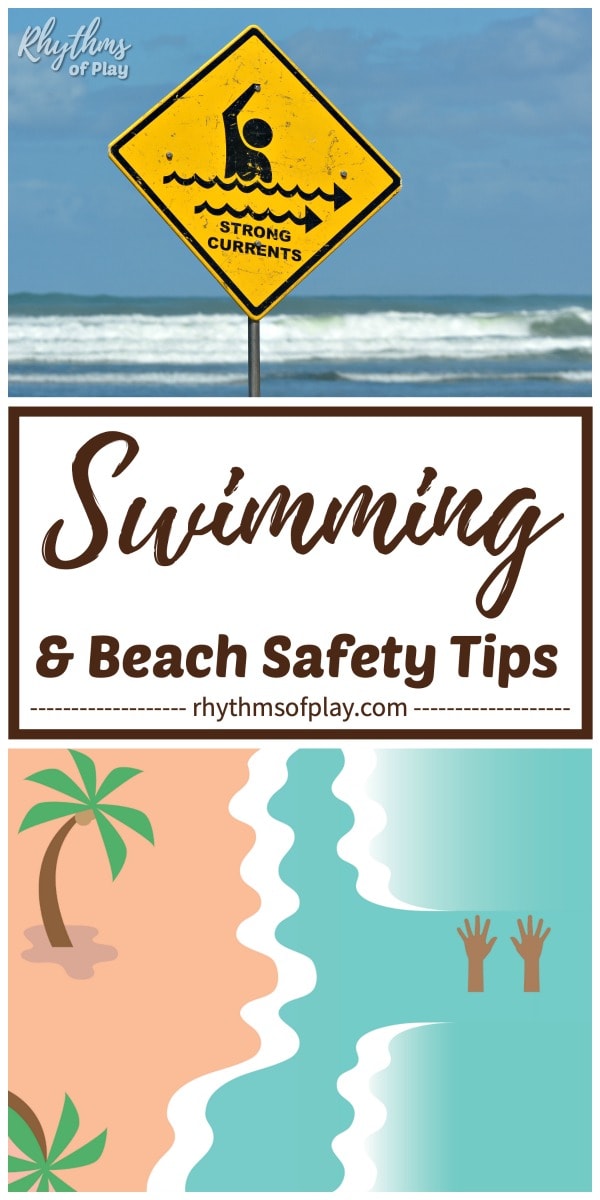
Related: 15 Ways to Raise a Helper
Beach and Water Safety Tips for Parents and Caregivers
Here’s a list of 25 swimming safety tips for beachgoers. But before I share them with you, I wanted to mention something important. After 20 years of talking to the public as an ocean lifeguard, I know we can sometimes be the bummer police. Because what we tell you is often not what you want to hear. Trust me when I tell you that we dislike that part of our job more than you do. Please understand that we aren’t trying to ruin your day. We’re trying to do our job the best we can to make sure that you and your children go home safely.
Related: 8 reasons I allow my child to go barefoot
25 Beach and Swimming Safety Tips from an Ocean Lifeguard Mom
1. Always swim near an open lifeguard tower
Only swim near an open lifeguard tower. You risk your safety when swimming in an area with no lifeguard. Typically lifeguards are never without their rescue can or tube. There is a lifeguard in this tower because the rescue can is hanging. (The guard on duty happens to be my husband.) If the shutters are open, and you don’t see the rescue can or tube anywhere on the tower, look for the lifeguard on duty on the beach. They are usually easy to spot in their uniform, holding a red or yellow rescue can or tube.
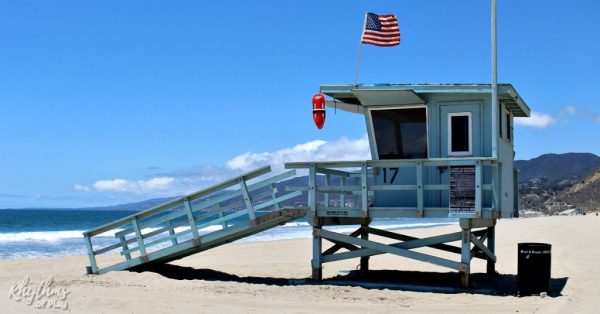
Personal Story of Why It’s Best to Swim Near a Lifeguard (and How I Became One)
Before Kauai, HI had lifeguards, the locals were responsible for rescuing tourists whenever they got in trouble. When I lived there for a few years in the late ’80s, I frequented a beach called Lumahi, nicknamed Luma-die, because of the number of drownings there.
As I was walking down the beach with a friend, he said, “We’re going to make some rescues today–are you ready?” When I gave him a look as if to say, “What are you talking about?” He pointed out a rip current that the river and storm surf created together, pulling next to a rock jetty that made it even worse.
Together the river current and storm surf next to a natural rock jetty created one of the biggest and strongest currents possible. The sandy beach berm often stopped the river, but not this day. The massive surf knocked it down, and the river flowed like a wild water ride straight into the sea and off into the horizon.
About an hour later, we had fun taking turns with some of our friend’s body surfing in it. The ocean and river currents were so powerful that they created a standing wave that could be surfed forever, or at least until you got “sucked out” into the ocean.
When this happened, locals like Lyon and Laird Hamilton, the Irons brothers (Bruce and his late brother Andy), and the late Keoni Lucas, knew to begin swimming down the beach away from the river parallel to shore. And because we made it look so fun, others thought they would try our natural wild water ride.
Unfortunately, tourists did not know how to swim back to safety, and many died. So the sign in the parking lot that read Lumahi Beach was crossed out, and LUMA-DIE was written in its place as a sort of crude warning from the locals, but it didn’t do much good.
You can do it!
Suddenly, my friend took off, heading out to sea screaming, “Come on!” He swam toward a tourist couple that had gotten sucked out. When we arrived, they were in total panic, barely keeping their heads above water. He shouted, “Help her!” as he continued toward the man.
I stopped swimming a short distance from her, told her I could help her, and everything would be okay. Next, I asked her if she could swim, and she nodded yes, so I told her to follow me. When I saw a big set wave coming, I told her to take a deep breath and hold it. Then, as I took a deep breath, I grabbed her, turned us around, and kicked us into the wave so we could ride it to shore.
We went under and tumbled toward shore for an eternity, it’s not easy to body surf entangled with another person, but thankfully, the force of the wave pushed us close enough that I could reach the bottom with my feet and drag her slowly to safety. At that moment, the lifeguard in me was born. I had saved someone’s life and was forever changed by it.
How I Became a Los Angeles County Ocean Lifeguard
When I moved back to Santa Monica a few years later, I joined the Santa Monica College Swim team to be ready for the tryout swim to become a Los Angeles County Ocean Lifeguard for the Los Angeles County Fire Department in 1994.
After making the qualifying cut in the one-mile ocean swim and passing the interview, I was invited into an intense para-military ocean lifeguard training program. I graduated from the Los Angeles County Fire Department Ocean Lifeguard Training Academy in 1994, worked as an ocean lifeguard and junior lifeguard instructor for 20 years, and retired from service in November 2014.
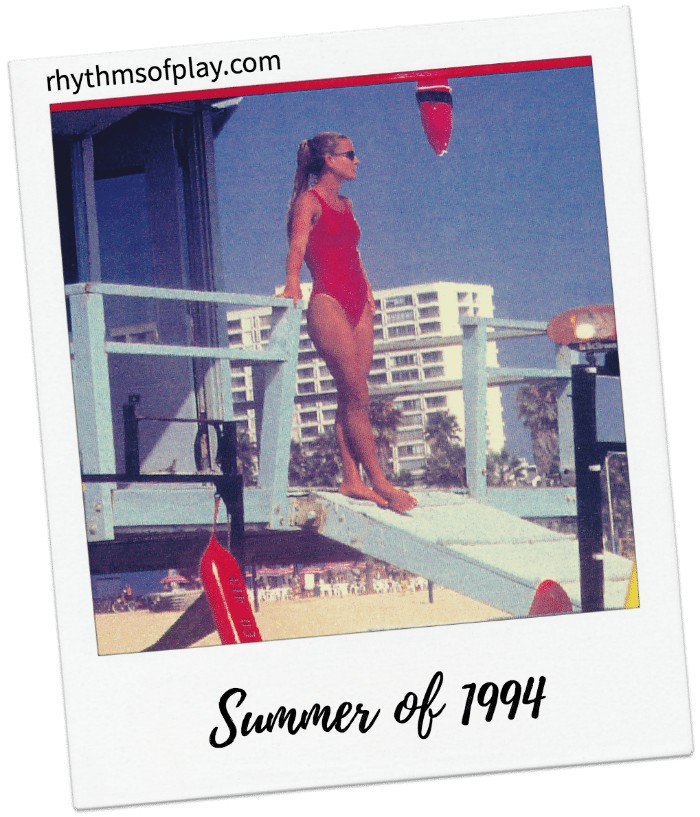
2. Ask the lifeguard about beach safety, water safety, and ocean conditions
The best advice is to talk to the lifeguard and ask questions before heading into the water. Lifeguards are more than happy to teach and inform the public. It’s our job, and it helps pass the time. So go ahead and ask!
3. Pay attention to beach flags and swimming safety signs and learn what they mean
Most beaches and lifeguard organizations will have beach safety signs, flags, and cones to inform the public about beach and ocean conditions. Not all beaches and organizations use the same swimming safety signs and flags, and some don’t even use them in the same way.
Some organizations use flags of various colors to communicate the ocean conditions, so residents know at first glance what to expect. This makes it a good idea to check with the lifeguard on duty to learn more.
The photo collage below contains examples of some beach safety signs that you might see. They often mark areas to stay away from due to strong currents, piers, and jetties. Some beach safety signs designate emergency vehicle access and areas to keep clear in an emergency.
In Los Angeles County, the ocean lifeguards must also place a cone perimeter around all lifeguard towers for emergency vehicle access. Please keep this area clear, or the lifeguard on duty will have to ask you to move. Rember what I said about the bummer police earlier? We don’t like that part of our job very much either.
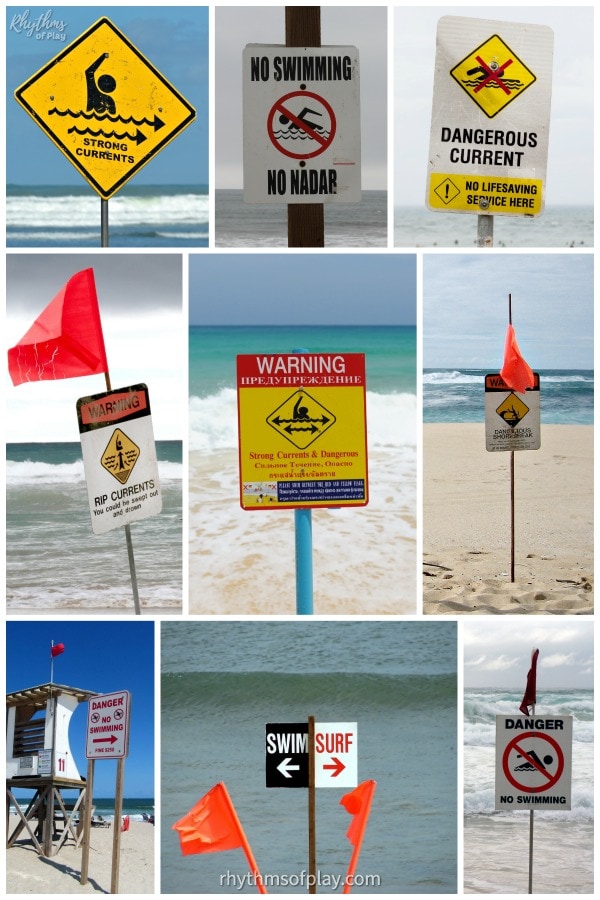
Some swimming safety signs designate swim and surf areas. There will usually be a flag and a sign with an arrow pointing toward the swim area and an arrow pointing toward the surf area, as shown in the photo collage above. Another water safety flag you might see is the “blackball flag.” The “blackball flag” is a yellow flag with a black ball in the middle.
When you see the black ball flag flying, no surfing is allowed except in designated surfing areas. Unfortunately, large beach crowds can sometimes cause the lifeguards to shut down surf areas to keep everyone safe.
4. Teach children to go to the nearest lifeguard when “lost.”
Teach children to go to any lifeguard tower when they find themselves lost. And if you ever find anyone in your party missing, go to the nearest lifeguard tower the second you realize it. No harm, no foul.
All lifeguard organizations deal with lost children (and adults) daily and have a system to return them to their parents safely. In my 20 years of service, I have never heard of a missing child (or missing parents) that were not reunited using this system.
5. Stay close to the little ones
Little ones can easily get lost, knocked down by small waves, and slip into inshore holes quicker than you can blink an eye. Children have drowned in only a few feet of water because they could not get up after falling. Keep children close to you to keep them safe in the water.
6. Learn to identify inshore holes and rip currents
Inshore holes happen when large surf digs a hole in the shallow areas on the beach. These areas are especially dangerous for young children bouncing along in the shallows when they suddenly find themselves underwater and cannot swim. One minute your child will be happily bouncing away; the next, they will be gone. Watch children closely and keep them out of areas with inshore holes.
You can spot inshore holes because the water is usually a bit darker in an area where there is a hole. People are often deceived by these holes and think they are safer to swim because the surf is smaller, but these areas are the most dangerous places to swim on the beach.
Rip currents will often pull out of an inshore hole. Waves rush into them as they crash to the shore and find an easy way out by filling into inshore holes. As soon the person can no longer touch the bottom, they will be pulled out to sea in the rushing water. Often, the person will be completely unaware of this until it is too late.
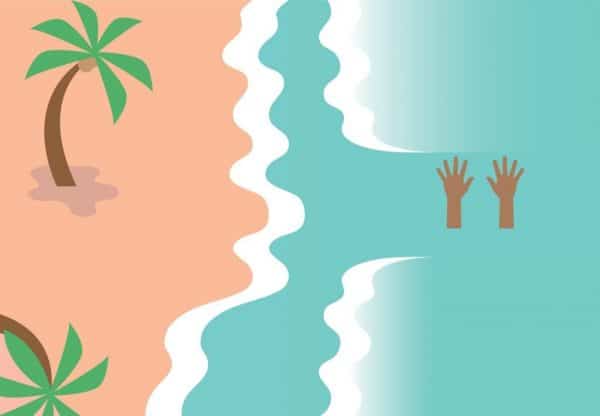
What is a rip current, and how do you get out of one?
A rip current is a river of water heading out to sea, as shown in the graphics above and below. Stay calm when and if you find yourself getting pushed out to sea. You are probably in a rip current. If you are on a surfboard or bodyboard, stay on it. Do not jump off and attempt to swim to shore.
The swimming safety graphic below shows how to get out of a rip current safely. When you are in a rip current, not making any forward progress, swim or kick parallel to the shore. Or wait for the lifeguard to come to help you. Trust me. The lifeguards see you getting sucked out and are on their way.
They are probably standing on their deck looking at you through their binos or grabbing their lifeguard can and heading your way. They might even be whistling at you and waving you in to ensure you need help. If you don’t do anything or are having trouble, the lifeguard will come to get you. Just stay calm. Often “victims” are not drowning; they just need a little help.
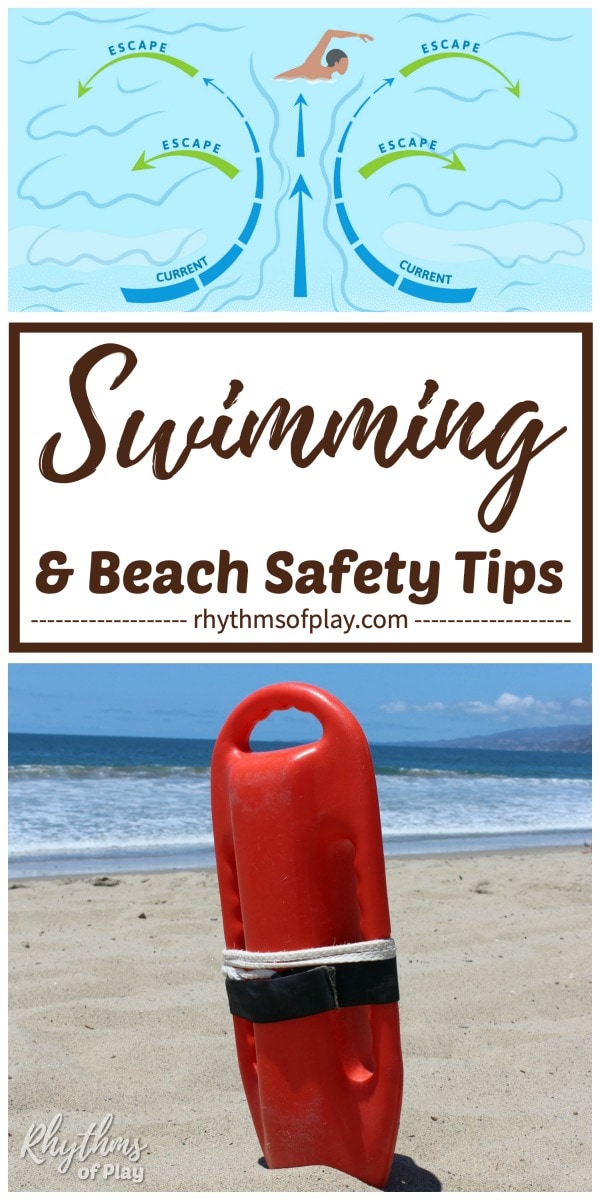
7. Look toward shore when you hear whistling or yelling
When you hear whistling or yelling, look towards the beach to ensure it’s not a lifeguard trying to get your attention. One of their mottos is “prevents before rescues.” Lifeguards approach and inform the public to prevent rescues instead of waiting until someone is “drowning” before they take action.
Follow their directions if you see a lifeguard motioning you to move down the beach or come to shore. They might be trying to move you out of a dangerous area where there is a hole, rip current, pier, or rocks nearby. So please move in the direction that the lifeguard is pointing or motioning towards.
And if you have any questions about what’s going on, please feel free to ask. Ocean lifeguards are there to teach, inform, and make sure everyone goes home safe and happy–it’s our job!! We are always pleased to teach you and your family about ocean conditions and water safety. So if you ever find yourself confused or want to learn more, ask the lifeguard what’s up.
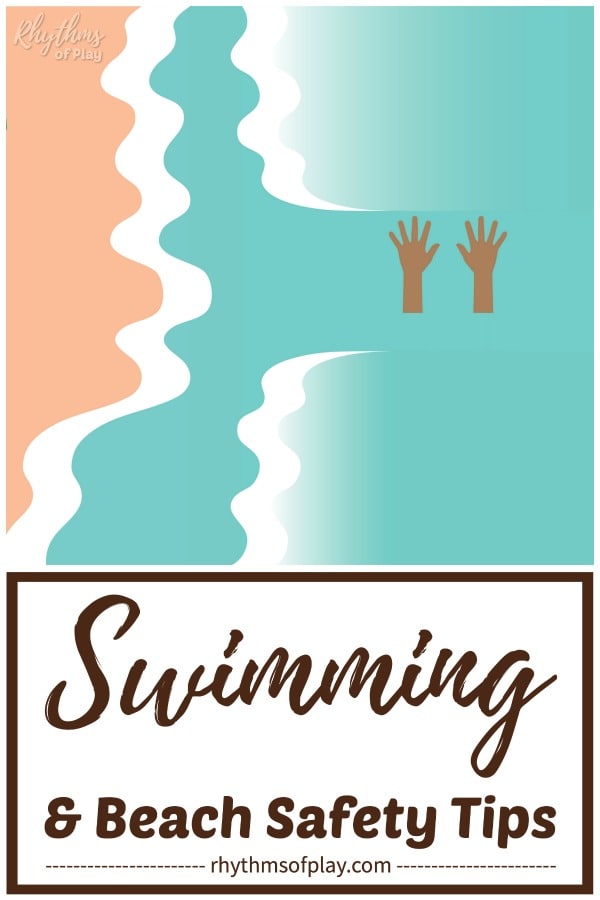
8. Apply sunblock often and bring shade if you plan to stay a while
Chemical sunscreens are dangerous and cause many problems, including skin cancer! There are lots of fantastic choices on the market today that don’t contain chemicals. Use a chemical-free sunblock that contains only zinc or titanium as the active ingredient. Re-apply every few hours when swimming.
Bring some shade to the beach if you plan to stay awhile. Hats, clothing, rash guards with sun protection, beach umbrellas, or pop-ups are all great options. Unfortunately, regular tents are not allowed on the beach. If you want to use a tent… try a beach tent!
If you use a pop-up, don’t move it closer to shore than the lifeguard towers. Pop-ups closer to shore can obstruct the lifeguards’ vision. If the pop-up blocks swimmers, the lifeguard will tell you to take it down or move it. That’s a big bummer for everyone.
Umbrellas can go closer to shore but be prepared for a lifeguard to come to ask you to lower it if they can’t see the kids in the water behind it. Thank you so much for your understanding about this. We want to be able to see your kids and make sure they are safe!
9. Keep your children far away from storm drains at the beach, even when closed
Wherever there is a storm drain, there is toxicity. Due to illegal dumping into gutters, most storm drains are contaminated with highly toxic substances. Everything in the street eventually travels down storm drains into our ocean. Even when closed, these areas often have a build-up of poisonous substances. Keep your children and family as far away from them as possible!
10. Stay away from rocks, jetties, and piers
There are several dangers to be found in rocks, jetties, and piers:
- They often have rip currents pulling right next to them, and it is effortless to forget exactly where you are and get pushed into them, causing severe injuries.
- There are often unexposed rocks or pilings just below the water’s surface.
Often these areas are marked with flags, signs, and even buoy lines to keep people out of danger. Keep your family as far away from them as possible.
11. Please don’t swim near surfers or surf near swimmers
Here’s a helpful swimming safety tip. If you arrive in an area where surfers are present and do not see a designated surfing area, please find a spot where there are no surfers if you’d like to swim. It is unsafe for swimmers and surfers to be in the same place in the ocean. So, go with the first come, first served rule by finding your own space to swim if you don’t want to be bothered.
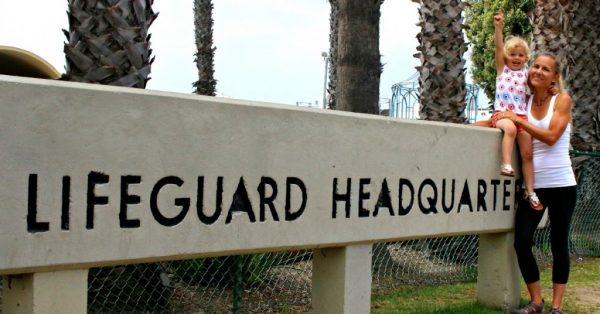
12. Always use a leash when surfing and a leash and fins when bodyboarding
There are a few reasons to use a leash and fins:
- You won’t lose your floatation and end up at risk.
- Your surfboard and bodyboard are less likely to hit someone when you use a leash.
- Fins make it easy to get out of rip currents. Just kick parallel to shore until you are free and clear.
13. Swim Parallel to shore, not out to sea
When enjoying the ocean, please do not swim straight out into the ocean or attempt to swim out to a buoy, breakwater, etc. Holding onto buoys and climbing onto breakwaters is also discouraged. Buoys and breakwaters are often farther than they look, and swimmers become too tired to make it back to shore.
Other dangers of swimming straight out are getting hit by passing boats or being stuck in rip currents. Please don’t put your life at risk. If you are a strong swimmer and want to swim around one of the buoys the lifeguards have set out, ask the lifeguard first.
14. Don’t use inflatables in the ocean
Bummer, police, I know, but there are many reasons for this water safety tip. Inflatables (including balls) are extremely dangerous in the ocean for several reasons:
- Inflatables can provide a false sense of security that causes people to go farther in the ocean than they would without them.
- An inflatable can pop into the surf and put a swimmer’s life at risk if they rely on it for floatation.
- It’s effortless to get sucked out into a rip current when floating around.
- Floaties you put on children’s arms can cause them to drown in the surf.
- Chasing after inflatables floating away is another way to put yourself at risk. It is more than likely that the inflatable is getting sucked out into a rip current. Don’t follow it out, or we might have to follow you.
There is one exception to the no inflatable rule. Coast Guard-certified inflatables are allowed in the ocean. Please only use designated launching and landing spots if you intend to use these. Ask the nearest lifeguard for more information or call your local Lifeguard Headquarters.
15. Don’t throw sand
Go ahead–tell your children that the lifeguard said no sand-throwing. And feel free to send them over to the lifeguard tower to ask if they must. Sand-throwing is not allowed on the beach and is grounds for a citation on many beaches because it can cause injuries to the eyes of beach patrons not even involved in the sand war. So please tell your children to refrain from this malicious activity.
16. Don’t tunnel into berms or dig too deep of a hole–and please fill Them in before you leave the beach
Here’s another critical beach safety tip. Tunneling into sand berms is a hazardous activity because tunnels can collapse, and holes can cause injuries to unsuspecting passersby.
So please keep your children, and other beachgoers safe by filling in any holes you dig before you leave the beach. Holes in the sand can be dangerous to the unsuspecting passerby and cause serious injuries.
I know several lifeguards that have hurt themselves by falling into holes while running from their tower to make a rescue. Sometimes they were hurt so badly that they could not continue to make the rescue. Lifeguards have a fantastic backup system in place, so this has not resulted in a drowning–but it can.
Please fill in your holes. Lifeguards are not looking for them because they are busy watching the person in the water that they are running to save. If you like to dig in the sand, check out these tips on Building a Sand Castle.
17. Know about tides
There are generally two low tides and two high tides daily, with some exceptions that I won’t go into. When you put your stuff near the waterline when the tide is coming up, it will get wet and may even be washed out to sea.
If you place your stuff close to the water when the tide goes out, you should be fine unless you plan to stay all day. There are often tide boards on open lifeguard towers where you can read the high and low tides for the day.
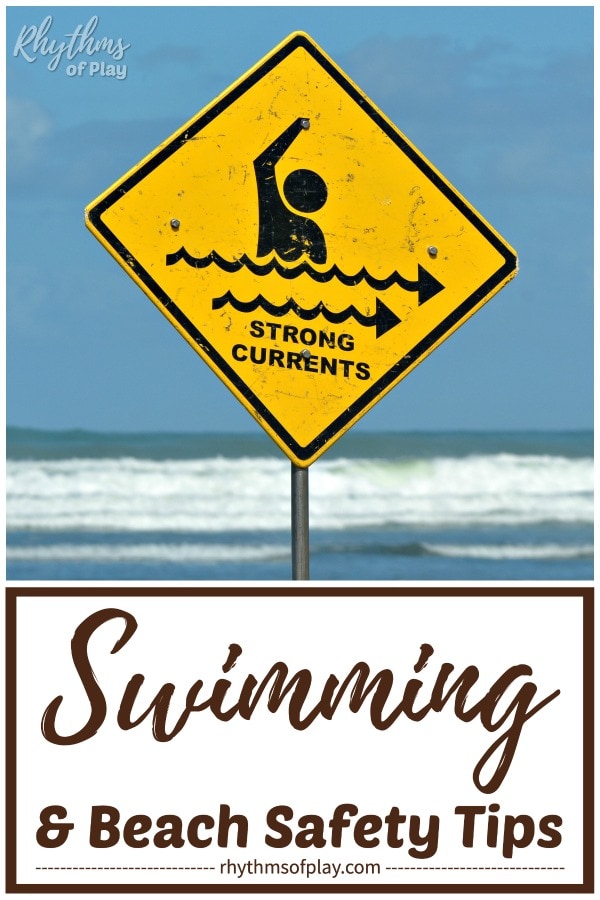
18. Shuffle your feet in shallow water
Shuffle your feet when in shallow water. This will alert all stingrays that you are coming, and they will know to stay away from you. Stingrays are like bees; they will only sting you if they feel in danger. They are most often stepped on when they sting someone.
Shuffle your feet, and you will easily prevent yourself from getting stung. If you are heading out to an area where there are already many swimmers, it is more than likely that they are long gone, but it is always better to be safe than sorry.
19. Know basic bee, jellyfish, and stingray first aid
Bee stings and jellyfish stings are most often minor injuries. Most lifeguard towers can treat both. Numbing agents like medicine are often used to treat the pain of a bee sting, while vinegar is excellent for neutralizing a jellyfish sting. Yes, the “Friends” episode is factual. You can also urinate on a jellyfish sting to provide relief–lol!
The danger of bee and jellyfish stings is when someone has an allergic reaction to the sting and goes into anaphylactic shock. This is a genuine life-threatening emergency. People who are allergic carry epi-pens and know how to use them to prevent this.
Some people are unaware they are allergic if they have never been stung. It is always best to have a lifeguard check them out. If you notice the sting victim having trouble breathing–notify the lifeguard and call 911 immediately!
Stingray injuries are more difficult to treat and often require an emergency room visit because you must remove the barb. Soak the area in hot water to draw the toxin out, and calmly make your way to the hospital.
20. Never dive into the water head first
Always put your hands out in front of you when diving into the water or ocean. Sandbars are often right where you least expect them! If you hit your head on the bottom, it can cause a neck or spinal cord injury.
21. Learn Signs & Symptoms of Spinal Cord Injuries.
Signs of a Spinal Cord Injury:
- Pain or tenderness in the neck or back.
- Cuts, scrapes, or abrasions to the head or face.
- Numbness or tingling in the arms and legs.
- Difficulty breathing.
- Weakness in the arms or legs.
- Partial or complete paralysis.
If someone has a suspected spinal injury:
- Get the lifeguard or dial 9-1-1.
- Advise the injured person not to move, especially the head, neck, or back.
- Help support their head and neck until help arrives.
22. Be aware when near or on a bike path
Bike paths are like roads. Be aware of your children, and be careful not to let them dart across without looking both ways first.
23. Hydrate, Hydrate, and Hydrate some more.
Bring plenty of water when you go to the beach and drink it often. Water is always the best. Drinks containing caffeine can lead to dehydration, which can lead to heat exhaustion and heat stroke when you don’t drink enough water.
Do you and your family a favor and bring lots of water to the beach–especially on a hot day. To cut down on waste, we filter our water and use reusable double-walled steel bottles that keep drinks cold (or hot) for hours.
24. Don’t drink alcohol and swim.
Bummer, police once again, I know. But the facts are clear and undeniable. Drinkers are sinkers. Plain and simple.
25. Don’t bring any glass to the beach.
Glass breaks easily and becomes dangerous to anyone that steps in the sand where the pieces lie.
One last thing — Please Don’t Litter.
Take only pictures (and maybe a few seashells), and leave only footprints. Thank you for keeping our beaches beautiful for everyone to enjoy. 🙂
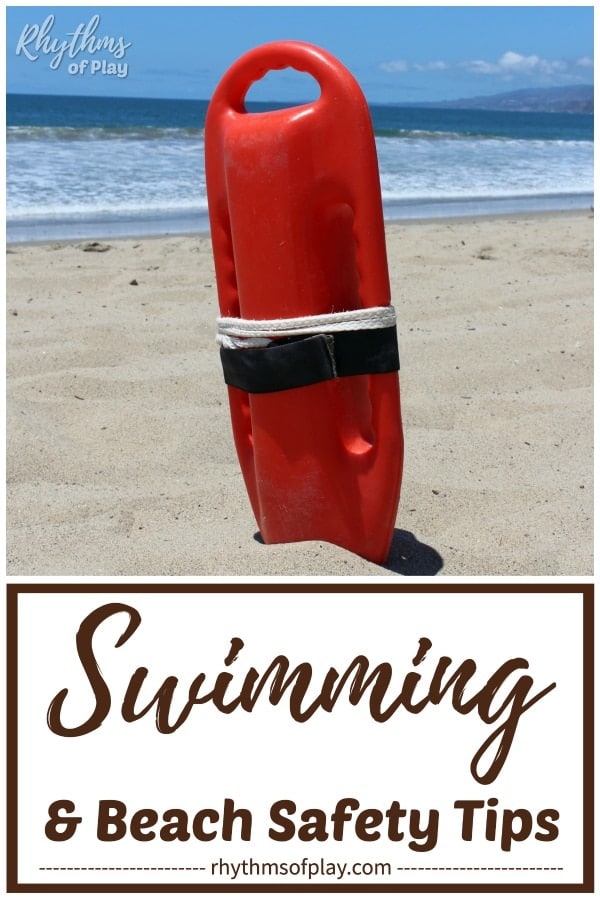
Related: Under the Sea Ocean Art Projects
Beach and Swimming Safety Tips for Kids and Families
There are many things to consider when considering beach and ocean safety, especially where the little ones are concerned. After reading these swimming safety tips, I hope you feel confident enough to keep yourself and your family safe at the beach so you can concentrate on having fun.
Don’t forget to check out our summer bucket list and this collection of outdoor activities for more fun ideas.
Learn more about Rhythms of Play HERE!
If You Liked Beach Saftey Tips, You Might Also Like
- Books That Teach Kids Important Life Lessons
- 15 Books Every Parent Should Read
- 8 Reasons I Allow My Child to Go Barefoot
- 15 Reasons to Climb a Tree and Other Benefits of Risky Play
- Soothing Sea Shells Sensory Bottle
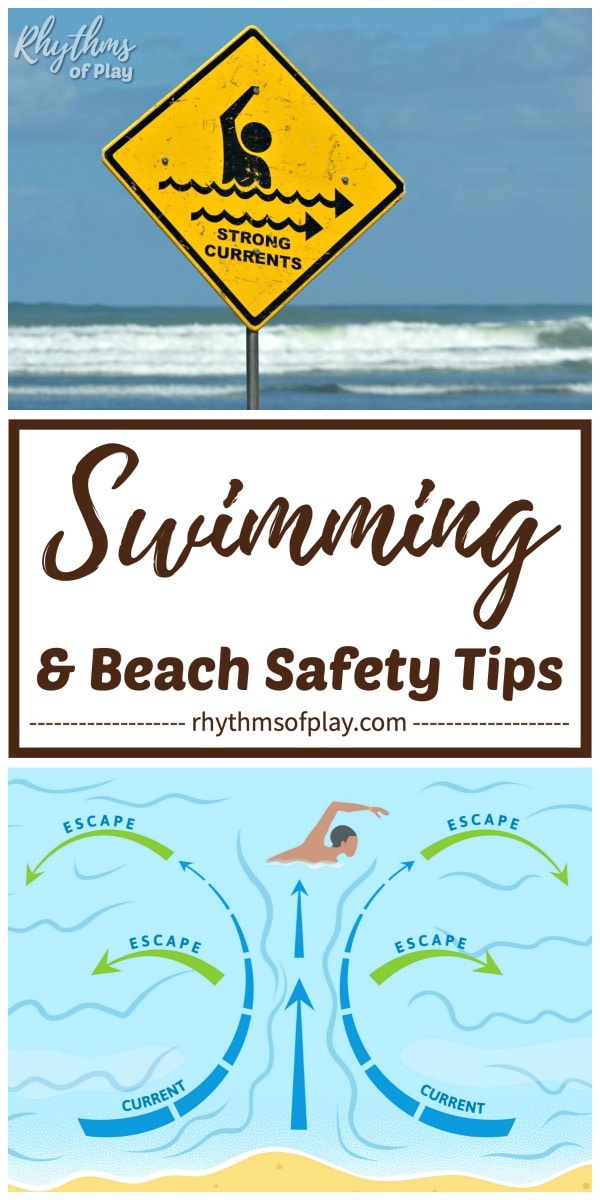

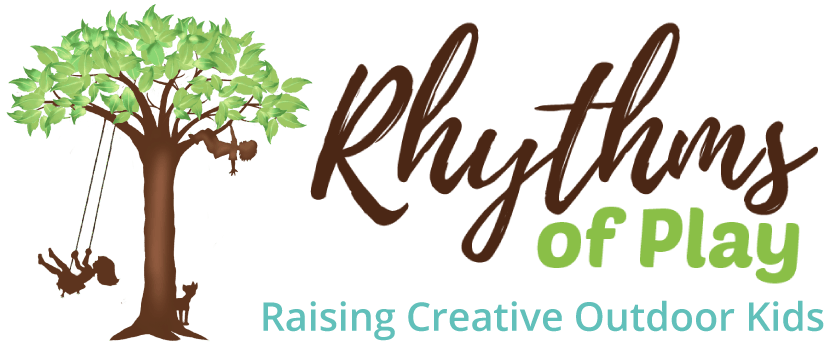
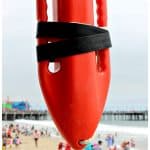


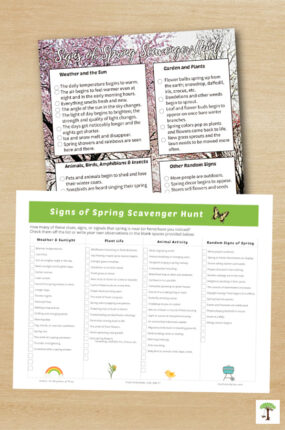




Thank you so much for this post! We are headed to South Carolina in two weeks to go to the ocean. It’s a big family event and there will be 9 kids there under the age of 13. These are really good tips especially knowing they came from a lifeguard that knows! Thank you so much!
You’re welcome! I’m so glad that you find it useful. Have a great trip!
Hey Nell,
Great article! I like when you emphasize the difference between the deep inshore holes where you cant touch or stand up, versus safely bouncing across the shallow sandbar. I have received some good feedback from this Rip Current Safety video:
https://vimeo.com/98610425
Thanks for stopping by Cosmo! [Cosmo is an LACO Ocean Lifeguard Specialist] And thanks for the excellent video on rip current safety. Hope you’ve been keeping those beaches safe without me 😉
My kids (5&7 years old) got interested in lifeguards and we read your blog together to learn ocean safety. We go to the beach almost everyday, but there were so many things I did not know which were all helpful. I really appreciated your information. Thank you!
You’re welcome, Amy! I’m so glad you and your kids found it helpful! If your kids are interested in lifeguards, many organizations have Junior Lifeguard programs. I was an instructor for LACO. Call or google your local lifeguard organization to find out more 🙂